"Unless you try to do something beyond what
you have already mastered, you will never grow."
AUTHOR: Ralph Waldo Emerson
COMPOSER
GERSHWIN

AN AMERICAN IN PARIS
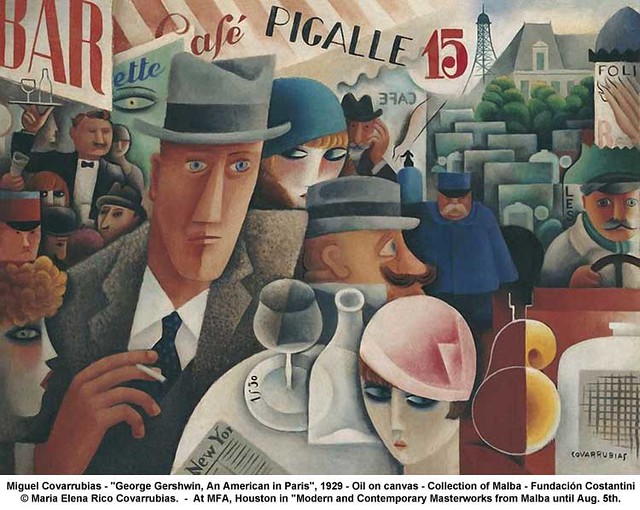 |
| http://www.flickr.com/photos/artimageslibrary/7349166376/ |
George Gershwin, Piano
An audio slip of George Gershwin himself
playing his concerto "An American in Paros"
on the piano, recorded c. 1930.
AN AMERICAN IN PARIS
Symphonic Tone Poem
Gustavo Dudamel, Conductor
Los Angeles Philharmonic Orchestra
Los Angeles Philharmonic Orchestra
AN AMERICAN IN PARIS
Symphonic Tone Poem
Tilson Thomas, Conductor
Wiener Symphoniker
https://www.youtube.com/watch?t=10&v=y2rcVS6eyR8
.jpg)
Symphonic Tone Poem
Tilson Thomas, Conductor
Wiener Symphoniker
https://www.youtube.com/watch?t=10&v=y2rcVS6eyR8
.jpg)
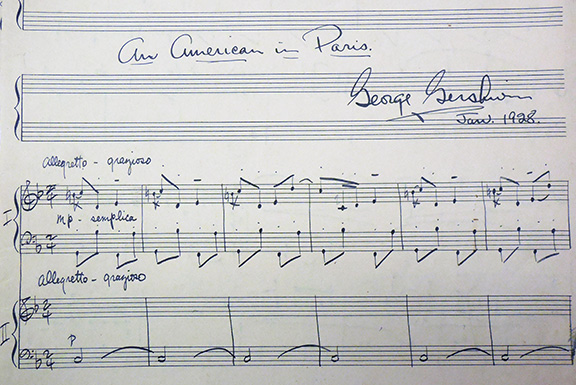 |
| Detail from the duo piano version of An American in Paris http://www.music.umich.edu/ami/gershwin/?p=213 |
AN AMERICAN IN PARIS
Version for Two Pianos
Chris Reynolds and Garrick Olsen, Piano Duo
Gershwin composed this symphonic
tone poem, An American in Paris, on
commission from the New York
Philharmonic.
 |
| George Gershwin in the 1920's (Library of Congress) |
It was inspired by his European
wandering round the city on foot
(portrayed in his music by the opening
section with a jaunty "walking theme,"
just about the tempo of his own Paris-
traipsing gait) exploring the usual
tourist sites
section with a jaunty "walking theme,"
just about the tempo of his own Paris-
traipsing gait) exploring the usual
tourist sites
and absorbing the
sights and energy of the city.
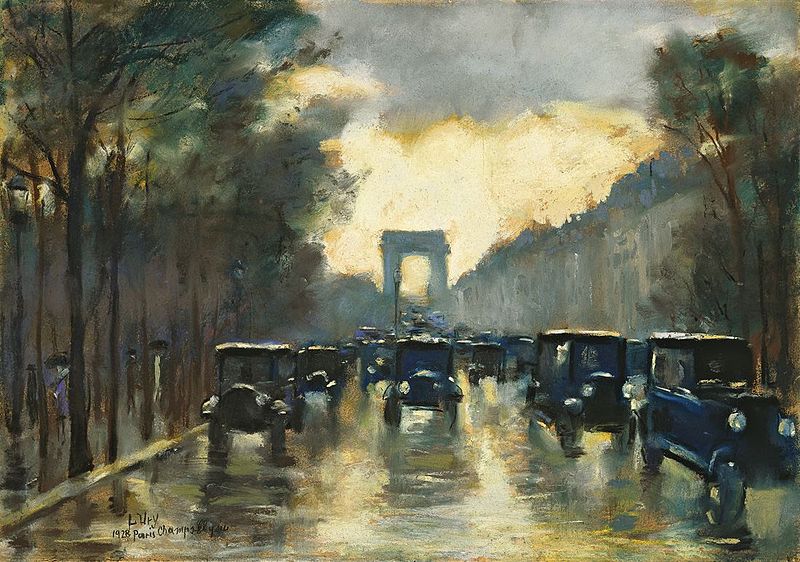 |
| Lesser Ury Champs-Elysees mit Arc de Triomphe, 1928 |
Impressed by the sound of Parisian
taxi cabs, he also visited an auto parts
Parisian taxi cab horns
to bring back to America to be
used in his composition.
Gershwin had composed the opening
music section of An American in Paris
but that was as far as he could get. To
help him evoke the sights and energy
of 1920's Paris he needed another,
longer visit to La Ville-Lumière


(the city of light) to tie down the rest
of his "rhapsodic ballet." He returned
in March of 1928
 |
| Gershwin arriving in Vienna, 1928 on his European trip |
where he met with some
famous European composers as
Ravel, Stravinsky, Prokofiev, Poulenc
and Milhaud who graciously welcomed him.
 |
| (Lt-Rt) Igor Stravinsky, Darius Malhaud, and Gershwin |
.jpg) |
| (Lt-Rt) Maurice Ravel, Igor Stravinsky, and Gershwin |
 |
| http://www.palacepianos.com/portal/piano-pedia/342- george-gershwin.html |
Gershwin was back in New York
on June 20th and had the piano sketches
for An American in Paris wrapped up

on June 20th and had the piano sketches
for An American in Paris wrapped up
within 6 weeks. This time, Gershwin
proudly orchestrated the work himself.
(he did not orchestrate his musicals),
scoring An American in Paris for the
standard instruments of the symphony
orchestra plus celesta,

saxophone, and included were
those automobile horns.
those automobile horns.
It took him an agonizing
2-1/2 months to complete.
2-1/2 months to complete.
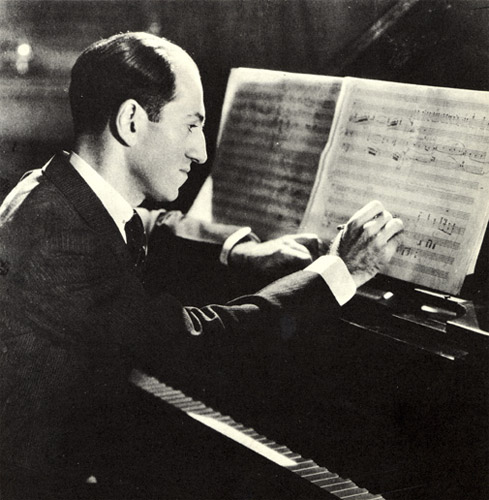
When he finished An
Gershwin had less than four weeks
until the American premiere at
Carnegie Hall
in which Walter Damrosch
conducted the
New York Philharmonic
 |
| http://www.broadway.com/buzz/180246/dance-through-the-80-year-history- of-gershwins-an-american-in-paris-from-carnegie-hall-to-broadway/ |
on December 13, 1928.
 |
| George Gershwin with Walter Damrosch, the conductor who commissioned An American in Paris for the New York Philharmonic |
Gershwin did not particularly like Walter Damrosch's
interpretation at the world premiere of An American
in Paris. He stated that Damrosch's sluggish, dragging
tempo caused him to walk out of the hall during a
matinee performance of this work.
 |
| http://archives.nyphil.org/index.php/artifact/9ba0cd3e- 37e7-4565-be31-6d647e315071/fullview#page/1/mode/2up |
The audience, according
to Edward Cushing,
responded with
"a demonstration of enthusiasm impressively
genuine in contrast to the conventional
applause which new music, good and bad,
ordinarily arouses."
Critics believed that An American in Paris was better
crafted than his lukewarm Concerto in F.
CONCERTO IN F
For Piano and Orchestra
Roy Bargy, Piano
Paul Whiteman and His Orchestra
to Edward Cushing,
responded with
"a demonstration of enthusiasm impressively
genuine in contrast to the conventional
applause which new music, good and bad,
ordinarily arouses."
Critics believed that An American in Paris was better
crafted than his lukewarm Concerto in F.
CONCERTO IN F
For Piano and Orchestra
Roy Bargy, Piano
Paul Whiteman and His Orchestra
Some did not think it belonged in a program with
classical composers César Franck, Richard Wagner,
or Guillaume Lekeu on its premiere. Gershwin
responded to the critics,
"It's not a Beethoven Symphony, you know... It's a
humorous piece, nothing solemn about it. It's not
intended to draw tears. If it pleases symphony
audiences as a light, jolly piece, a series of
impressions musically expressed, it succeeds."
http://web.vipwiki.org/movie/details/16168/an-american-in-paris.html
The following example is the first
recording of this that was ever made,
for RCA Victor, in 1929 with
Nathaniel Shilkret and the
%2C%2B1889%2C.jpg) |
| Maxmilien Luce: Quai de l’École, Paris, le Soir (Paris, Evening), 1889 |
recording of this that was ever made,
for RCA Victor, in 1929 with
Nathaniel Shilkret and the
 |
| Nathaniel Shilkret |
Victor Symphony Orchestra.
 |
| http://www.allmusic.com/artist/victor-orchestra-mn0000950609 |
Nathaniel Shilkret (1889-1982) was born in
New York, to an Austrian immigrant family.
He was an American composer, conductor,
clarinetist, pianist, business executive (A&R
man), and music director (Victor, RKO and
MGM). He conducted the orchestra for the
premier recording of George Gershwin's
symphonic poem An American in Paris, in
1929. This recording was one of five
recordings conducted by Nathaniel Shilkret
that eventually earned Grammy Awards.
It features the composer, Gershwin,
playing the brief celesta solo
during the slow section.
embedded&v=U1_TSydZ1LQ#at=145
 |
| Vincent Van Gogh: Bridge Across the Seine at Asnieres |
Gershwin provided insight into his
tone poem An American in Paris
in an interview for the magazine
in an interview for the magazine
Musical America, four months
before the work's premiere:
"This new piece, really a rhapsodic ballet,
is written very freely and is the most
modern music I’ve yet attempted.…
modern music I’ve yet attempted.…
The opening part will be developed in
typical French style, in the manner of
Debussy and the Six, though the
themes are all original.
typical French style, in the manner of
Debussy and the Six, though the
themes are all original.
My purpose here is to portray the
impressions of an American visitor
in Paris as he strolls about the city,
impressions of an American visitor
in Paris as he strolls about the city,
listens to various street noises,
and absorbs the French atmosphere.
 |
| LeRoy Neiman: An American in Paris |
As in my other orchestral compositions,
I've not endeavored to present any
definite scenes in this music. …The
rhapsody is programmatic only in a
general impressionistic way, so that
the individual listener can read into
the music such episodes as his
imagination pictures for him.
I've not endeavored to present any
definite scenes in this music. …The
rhapsody is programmatic only in a
general impressionistic way, so that
the individual listener can read into
the music such episodes as his
imagination pictures for him.
Our American friend, perhaps after
spasm of homesickness.
 |
| Maurice Utrillo: Sacre Coeur de Montmatre, Paris, 1937 |
The harmony here is both more intense
and simple than in the preceding pages.
 Edvard Munch: Street Lafayette, 1891 Within this bustling depiction of a French boulevard, used are contrasting techniques to convey a sense both of motion and immediacy. |
This 'blues' rises to a climax followed
by a coda in which the spirit of the music
returns to the vivacity and bubbling
exuberance of the opening part with
its impressions of Paris.
 |
| Thomas Kinkade: Paris |
At the conclusion,
the street noises and French
the street noises and French
atmosphere are triumphant."
 |
| Kees van Dongen: Avenue Du Bois |
The program notes written for
the premiere by Gershwin and
music critic Deems Taylor
 |
| Deems Taylor |
explains the story further:
An exuberant American
leads him on his way.
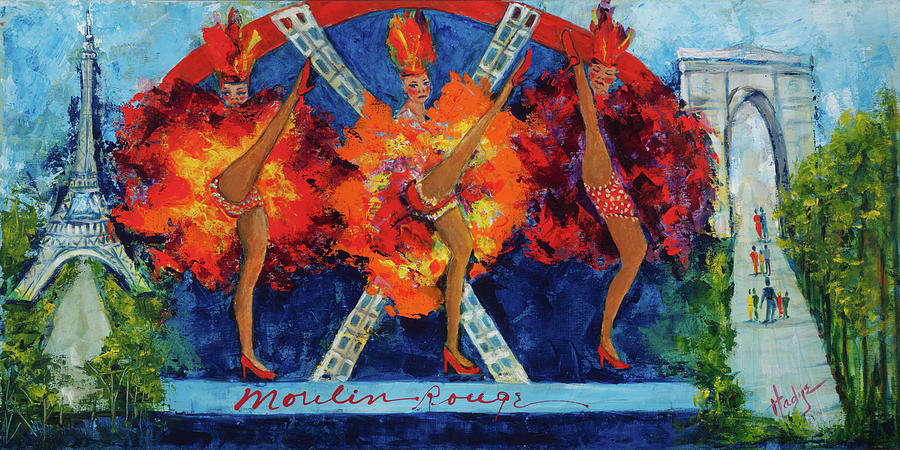 |
| Mary Ducharme: Moulin Rouge |
By the time the
Third Walking Theme
charming broken English."
Third Walking Theme
 |
| Fast Walking City |
appears, the American has
covered a good bit of territory.
covered a good bit of territory.
 |
| http://designspiration.net/image/172328645353/ |
Presently, a solo violin
"addresses him in mostcharming broken English."
The inevitable homesickness
overcomes him, but a compatriot
has appeared on the scene - a
"self-confident Charleston,overcomes him, but a compatriot
has appeared on the scene - a
without a drop of Gallic blood."
 |
| Will Bullas: An American in Paris (Traveler Chronicles) An American tourist at the Paris Opera |
The Second and Third
Walking Themes are heard,
interspersed by reminiscences
of the blues,
Walking Themes are heard,
interspersed by reminiscences
of the blues,
Vadik Suljakov: Moonlight Over Paris
|
but the general tone
is now one of optimism. There
is much in store for our hero.
is now one of optimism. There
is much in store for our hero.
 |
| Maurice Utrillo: Mont-Cenis Street, House of Berlioz, 1923 |
Mr. Taylor concludes,
"It will be great to get home, but,
meanwhile, this is Paris."
AN AMERICAN IN PARIS
ANALYSIS #1



.jpg)












AN AMERICAN IN PARIS
ANALYSIS #2
0005.jpg)
0006.jpg)
0007.jpg)
0008.jpg)
INFORMATION FROM:
http://en.wikipedia.org/wiki/An_American_in_Paris
The piece is structured into five sections,
http://en.wikipedia.org/wiki/An_American_in_Paris
The piece is structured into five sections,
which culminate in a loose ABA format.
Gershwin's first A episode introduces the
two main "walking" themes in the "Allegretto
grazioso" and develops a third theme in the
"Subito con brio." The style of this A section
is written in the typical French style of
composers Claude Debussy

and Les Six.
 |
| Les Six
Paris, 1920. Six composers: Georges Auric, Louis Durey,
Arthur Honegger, Darius Milhaud, Francis Poulenc,
and Germaine Tailleferre- convene in a café in
Montparnasse. Collectively known as Les Six, they
used wit and irreverence to change the course of
music in the 20th century.
|
This A section featured duple meter, singsong
rhythms, and diatonic melodies with the sounds
of oboe, English horn, and taxi horns. The B
section's "Andante ma con ritmo deciso"
introduces the American Blues and spasms
of homesickness. The "Allegro" that follows
continues to express homesickness in a faster
twelve-bar blues. In the B section, Gershwin
uses common time, syncopated rhythms, and
bluesy melodies with the sounds of trumpet,
saxophone, and snare drum. "Moderato con
grazia" is the last A section that returns to the
themes set in A. After recapitulating the
"walking" themes, Gershwin overlays the
In 1951, MGM released
the musical
the musical
featuring Gene Kelly and Leslie Caron.
Winning the 1951 Best Picture Oscar


the film was directed by
Vincente Minnelli,
Vincente Minnelli,
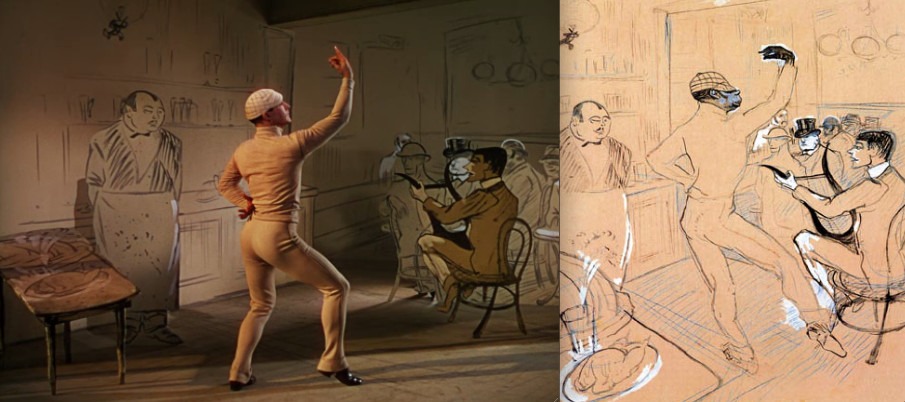 |
| Minnelli not only saw dancing within painting, but dancing through paintings. ~Emanuel Levy~ (Rt) Toulouse Lautrec: Chocolat Dansant Dans un Bar |
featured many tunes of Gershwin, and
concluded with an extensive, elaborate
dance sequence built around the
An American in Paris symphonic poem
(arranged for the film by Johnny Green),
costing $500,000.
https://vacheespagnole.wordpress.com/2011/11/13/1951
-an-american-in-paris-art-and-vincente-minnelli/
-an-american-in-paris-art-and-vincente-minnelli/
 |
| Jean Dufy: Place de la Concorde and the Madeleine |
 |
| Raoul Dufy: The Place de la Concorde |
 |
| Jean Dufy: The Place de la Concorde |
LINKS
http://www.princeton.edu/~achaney/tmve/wiki100k/docs/An_American_in_Paris.html
http://www.1920sera.com/arts/music/george-gershwins-an-american-in-paris/
https://prezi.com/9kmnzg3szlg0/an-american-in-paris/
http://www.1920sera.com/arts/music/george-gershwins-an-american-in-paris/
https://prezi.com/9kmnzg3szlg0/an-american-in-paris/
 |
| Raoul Dufy: Paris |
Gershwin-Rhapsody%20in%20Blue.pdf
https://mospace.umsystem.edu/xmlui/bitstream/handle/
10355/43561/FowlerRecGeoGer.pdf?sequence=1
https://mospace.umsystem.edu/xmlui/bitstream/handle/
10355/43561/FowlerRecGeoGer.pdf?sequence=1
 |
| Raoul Dufy: Paris in the Spring |
MORE PARIS IN ART
BY THE BROTHERS DUFY
BY THE BROTHERS DUFY


(Left to right) Brothers: Raoul and Jean Dufy
 |
| Jean Dufy: Le Pont Carrousel, 1947 |
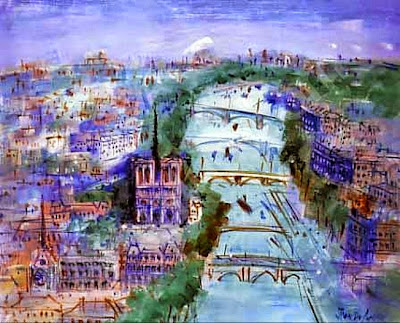 |
| Jean Dufy: The Seine and Notre Dame |
 |
| Raoul Dufy |
 |
| Jean Dufy: Ile de la Cité, Paris |
 |
| Jean Dufy: Moulin Rouge |
AN AMERICAN IN PARIS
LESSON PLANS
Heros and Music







.jpg)








.jpg)
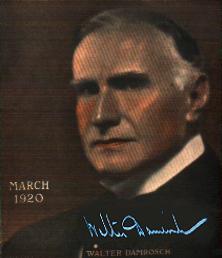










.jpg)


.jpg)
.jpg)
.jpg)
.jpg)

.jpg)


.jpg)

0003.jpg)
0004.jpg)
0009.jpg)

.jpg)








